Comparing data in Excel is a common task, and understanding How To Compare 2 Cells In Excel And Highlight Differences is a valuable skill. At COMPARE.EDU.VN, we provide a comprehensive guide on cell comparison techniques, helping you identify matches and differences efficiently and effectively. Learn methods to analyze data effortlessly with advanced Excel features and highlighting techniques for quick data analysis.
1. Introduction: Mastering Cell Comparison in Excel with COMPARE.EDU.VN
Do you need to compare data in Excel but find it a daunting task? Identifying differences and similarities between cells can be crucial for data analysis and decision-making. Whether you’re a student, a professional, or just someone trying to manage data, COMPARE.EDU.VN offers the knowledge and tools you need to streamline your Excel comparisons. We’ll guide you through various methods, from simple formulas to advanced conditional formatting, ensuring you can master cell comparison and make informed decisions. By understanding these techniques, you can significantly improve your data handling skills. Learn effective cell comparison strategies, data matching in Excel, and highlighting techniques with COMPARE.EDU.VN’s detailed guidance.
2. Understanding the Basics of Cell Comparison
Before diving into advanced techniques, it’s essential to grasp the basics of comparing cells in Excel. This involves understanding how to use simple formulas to determine if two cells contain the same or different values.
2.1. Using the IF Function for Basic Comparison
The IF function is a fundamental tool for cell comparison. It allows you to check if a condition is true or false and return a specific value based on the result.
2.1.1. Formula for Matches
To find cells with identical content, you can use the following formula:
=IF(A1=B1,"Match","")This formula compares the values in cells A1 and B1. If they are the same, it returns “Match”; otherwise, it returns an empty string.
2.1.2. Formula for Differences
To find cells with different values, simply replace the equals sign with the non-equality sign (<>):
=IF(A1<>B1,"No match","")This formula returns “No match” if the values in A1 and B1 are different.
2.1.3. Combining Matches and Differences
You can combine both checks in a single formula:
=IF(A1=B1,"Match","No match")Or:
=IF(A1<>B1,"No match","Match")2.2. Handling Different Data Types
The IF function works well with various data types, including numbers, dates, times, and text strings. However, when comparing text, it’s important to consider case sensitivity.
2.2.1. Case-Insensitive Comparison
By default, Excel ignores case when comparing text values. For example, “Apple” and “apple” are considered the same.
2.2.2. Case-Sensitive Comparison with EXACT Function
To perform a case-sensitive comparison, use the EXACT function:
=IF(EXACT(A1,B1),"Match","No match")The EXACT function returns TRUE if the cells are identical, including case, and FALSE otherwise.
3. Advanced Techniques for Cell Comparison
Beyond the basics, Excel offers advanced techniques to compare cells based on specific criteria and highlight the differences.
3.1. Conditional Formatting for Visual Comparison
Conditional formatting allows you to apply formatting to cells based on certain conditions. This is particularly useful for visually identifying matches and differences.
3.1.1. Highlighting Matches
To highlight cells with identical entries:
- Select the cells you want to format.
- Go to Conditional Formatting > New Rule > Use a formula to determine which cells to format.
- Enter the formula:
=$A1=$B1(assuming row 1 is the first data row). - Choose a formatting style (e.g., fill color).
3.1.2. Highlighting Differences
To highlight cells with different entries, use the formula:
=$A1<>$B1
3.2. Using Named Ranges for Dynamic Comparison
Named ranges make your formulas more readable and easier to maintain. You can define a named range for each cell and use these names in your comparison formulas.
3.2.1. Defining Named Ranges
- Select a cell (e.g., A1).
- Go to the Formulas tab and click Define Name.
- Enter a name (e.g., CellA1) and click OK.
3.2.2. Using Named Ranges in Formulas
You can now use the named ranges in your formulas:
=IF(CellA1=CellB1,"Match","No match")3.3. Combining Functions for Complex Comparisons
You can combine multiple functions to perform more complex comparisons. For example, you can use the AND function to check multiple conditions.
3.3.1. Using AND Function
=IF(AND(A1>10,B1<20),"Condition Met","")This formula checks if the value in A1 is greater than 10 AND the value in B1 is less than 20.
3.3.2. Using OR Function
=IF(OR(A1="Yes",B1="No"),"Condition Met","")This formula checks if the value in A1 is “Yes” OR the value in B1 is “No”.
4. Comparing Multiple Cells
Sometimes, you need to compare more than two cells. Excel provides functions and techniques to handle multiple cell comparisons effectively.
4.1. Comparing Multiple Cells in the Same Row
You can use the AND or OR functions to compare multiple cells in the same row.
4.1.1. Finding Matches in All Cells
To find rows where all cells have the same value:
=IF(AND(A1=B1,A1=C1),"Full Match","")4.1.2. Finding Matches in Any Two Cells
To find rows where any two cells have the same value:
=IF(OR(A1=B1,B1=C1,A1=C1),"Match","")4.2. Using COUNTIF for Multiple Cell Comparison
The COUNTIF function can be used to count how many cells meet a certain criteria. This is useful for comparing multiple cells.
4.2.1. Counting Matches
=IF(COUNTIF(A1:C1,A1)=3,"Full Match","")This formula checks if all three cells (A1, B1, and C1) have the same value.
5. Practical Examples of Cell Comparison
To illustrate the concepts, let’s look at some practical examples of cell comparison in Excel.
5.1. Comparing Product Prices
Suppose you have a list of product prices from two different suppliers and you want to identify any price discrepancies.
5.1.1. Data Setup
| Product | Supplier A Price | Supplier B Price |
|---|---|---|
| Product 1 | $10 | $10 |
| Product 2 | $15 | $12 |
| Product 3 | $20 | $20 |
| Product 4 | $25 | $22 |
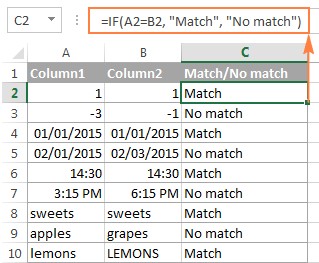
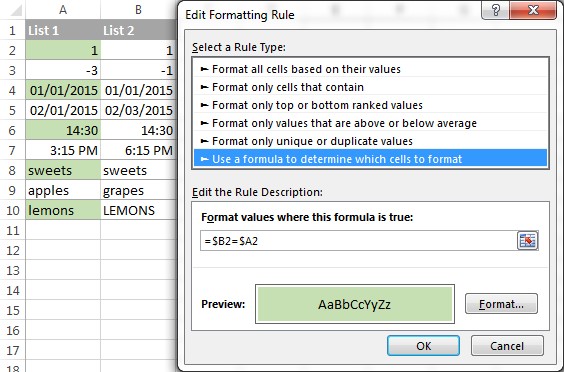
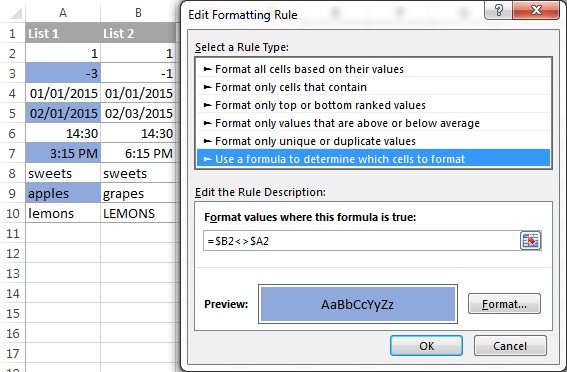
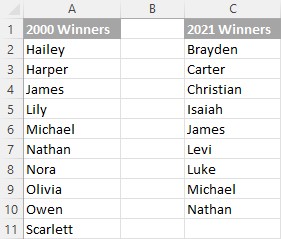
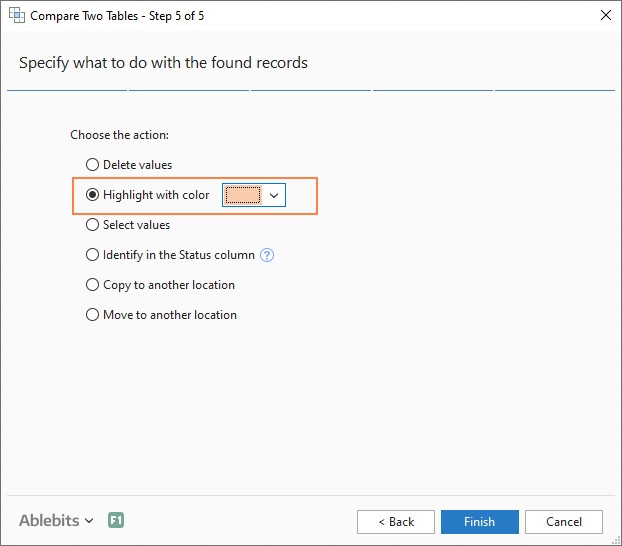
5.1.2. Comparison Formula
In column D, enter the formula:
=IF(B2=C2,"Match","Price Difference")This will show “Match” if the prices are the same and “Price Difference” if they are different.
5.1.3. Conditional Formatting
You can also use conditional formatting to highlight the price differences:
- Select column D.
- Go to Conditional Formatting > New Rule > Use a formula to determine which cells to format.
- Enter the formula:
=$B2<>$C2. - Choose a highlight color.
5.2. Comparing Dates
You can compare dates to check for deadlines, anniversaries, or other important events.
5.2.1. Data Setup
| Task | Start Date | End Date |
|---|---|---|
| Task 1 | 1/1/2024 | 1/15/2024 |
| Task 2 | 1/5/2024 | 1/20/2024 |
| Task 3 | 1/10/2024 | 1/25/2024 |
5.2.2. Comparison Formula
In column D, enter the formula:
=IF(C2>TODAY(),"Upcoming","Overdue")This will show “Upcoming” if the end date is in the future and “Overdue” if it is in the past.
5.2.3. Conditional Formatting
You can use conditional formatting to highlight overdue tasks:
- Select column D.
- Go to Conditional Formatting > New Rule > Use a formula to determine which cells to format.
- Enter the formula:
=$C2<TODAY(). - Choose a highlight color.
5.3. Comparing Text Strings
You can compare text strings to check for consistency, spelling errors, or other discrepancies.
5.3.1. Data Setup
| Item | Description A | Description B |
|---|---|---|
| Item 1 | Apple | Apple |
| Item 2 | Banana | Bannana |
| Item 3 | Orange | Orange |
5.3.2. Comparison Formula
In column D, enter the formula:
=IF(A2=B2,"Match","Spelling Error")This will show “Match” if the text strings are the same and “Spelling Error” if they are different.
5.3.3. Conditional Formatting
You can use conditional formatting to highlight spelling errors:
- Select column D.
- Go to Conditional Formatting > New Rule > Use a formula to determine which cells to format.
- Enter the formula:
=$B2<>$C2. - Choose a highlight color.
6. Troubleshooting Common Issues
While comparing cells in Excel, you may encounter some common issues. Here’s how to troubleshoot them.
6.1. Incorrect Results
If you’re getting incorrect results, double-check your formulas. Make sure you’re using the correct cell references and comparison operators.
6.1.1. Checking Cell References
Ensure that your cell references are accurate. Use absolute references ($A$1) if you want the cell reference to remain constant when you copy the formula.
6.1.2. Verifying Comparison Operators
Make sure you’re using the correct comparison operators (=, <>, >, <, >=, <=).
6.2. Formulas Not Updating
Sometimes, formulas may not update automatically.
6.2.1. Recalculating the Worksheet
Press F9 to recalculate the entire worksheet.
6.2.2. Setting Calculation Options
Go to Formulas > Calculation Options and make sure it’s set to Automatic.
6.3. Conditional Formatting Not Working
If your conditional formatting isn’t working, check the following:
6.3.1. Formula Accuracy
Ensure that your conditional formatting formula is accurate.
6.3.2. Rule Priority
Check the rule priority in the Conditional Formatting Rules Manager. Rules are applied in order, so make sure the correct rule is at the top.
7. Using Excel Add-Ins for Advanced Comparison
For more advanced comparison tasks, consider using Excel add-ins. These add-ins offer additional features and capabilities that can streamline your workflow.
7.1. Ablebits Ultimate Suite
Ablebits Ultimate Suite includes a Compare Two Tables tool that allows you to compare two lists or tables based on multiple columns. It can identify matches and differences and highlight them.
7.1.1. Comparing Two Lists
- Click the Compare Tables button on the Ablebits Data tab.
- Select the first list and click Next.
- Select the second list and click Next.
- Choose whether to search for matches or differences.
- Select the columns for comparison.
- Choose how to deal with the found items (e.g., highlight with color or identify in a status column).
7.1.2. Highlighting Duplicates
You can highlight duplicates in the selected color:
7.2. Kutools for Excel
Kutools for Excel offers a variety of tools for data analysis, including comparison tools. It can help you compare ranges, sheets, and workbooks.
7.2.1. Comparing Ranges
- Select the ranges you want to compare.
- Go to the Kutools tab and choose the comparison tool.
- Specify the comparison criteria and options.
8. Best Practices for Cell Comparison
To ensure accurate and efficient cell comparison, follow these best practices.
8.1. Keep Data Consistent
Ensure that your data is consistent and accurate. This includes checking for spelling errors, formatting inconsistencies, and other data quality issues.
8.2. Use Clear and Concise Formulas
Use clear and concise formulas that are easy to understand and maintain. Avoid overly complex formulas that can be difficult to troubleshoot.
8.3. Document Your Formulas
Document your formulas using comments. This will help you and others understand the purpose of the formula and how it works.
8.4. Test Your Formulas
Test your formulas thoroughly to ensure they’re producing accurate results. Use a variety of test cases to cover different scenarios.
8.5. Use Named Ranges
Use named ranges to make your formulas more readable and easier to maintain.
8.6. Apply Conditional Formatting Wisely
Apply conditional formatting wisely to highlight important information and make your data easier to understand.
9. Advanced Excel Functions for Cell Comparison
To enhance your cell comparison skills, explore these advanced Excel functions:
9.1. VLOOKUP
VLOOKUP is a powerful function for finding data in a table or range.
9.1.1. Syntax
=VLOOKUP(lookup_value, table_array, col_index_num, [range_lookup])- lookup_value: The value to search for.
- table_array: The range of cells to search in.
- col_index_num: The column number in the table array to return the matching value from.
- range_lookup: An optional argument that specifies whether to find an exact or approximate match (TRUE for approximate, FALSE for exact).
9.1.2. Example
=VLOOKUP(A2,$E$2:$F$10,2,FALSE)This formula searches for the value in A2 in the range E2:F10 and returns the value from the second column (column F) if an exact match is found.
9.2. INDEX MATCH
INDEX MATCH is a flexible alternative to VLOOKUP. It can perform more complex lookups and is less prone to errors.
9.2.1. Syntax
=INDEX(array, MATCH(lookup_value, lookup_array, [match_type]))- array: The range of cells to return a value from.
- lookup_value: The value to search for.
- lookup_array: The range of cells to search in.
- match_type: An optional argument that specifies the type of match (0 for exact match).
9.2.2. Example
=INDEX($B$2:$B$10,MATCH(A2,$A$2:$A$10,0))This formula searches for the value in A2 in the range A2:A10 and returns the corresponding value from the range B2:B10 if an exact match is found.
9.3. XLOOKUP
XLOOKUP is a modern lookup function that combines the capabilities of VLOOKUP and INDEX MATCH. It is available in Excel 365 and later versions.
9.3.1. Syntax
=XLOOKUP(lookup_value, lookup_array, return_array, [if_not_found], [match_mode], [search_mode])- lookup_value: The value to search for.
- lookup_array: The range of cells to search in.
- return_array: The range of cells to return a value from.
- if_not_found: An optional argument that specifies the value to return if no match is found.
- match_mode: An optional argument that specifies the type of match (0 for exact match).
- search_mode: An optional argument that specifies the search direction.
9.3.2. Example
=XLOOKUP(A2,$A$2:$A$10,$B$2:$B$10,"Not Found",0)This formula searches for the value in A2 in the range A2:A10 and returns the corresponding value from the range B2:B10 if an exact match is found. If no match is found, it returns “Not Found”.
10. Using AI for Enhanced Cell Comparison
Leveraging AI tools can significantly improve the speed and accuracy of cell comparison.
10.1. AI-Powered Excel Add-Ins
Several AI-powered Excel add-ins can assist with data analysis and comparison. These tools use machine learning algorithms to identify patterns, anomalies, and relationships in your data.
10.1.1. Microsoft Excel Insights
Microsoft Excel Insights uses AI to analyze your data and provide insights, such as trends, outliers, and correlations.
10.1.2. Third-Party AI Add-Ins
Explore third-party AI add-ins for Excel that offer advanced data analysis and comparison capabilities. These tools can automate repetitive tasks and provide deeper insights into your data.
10.2. Natural Language Processing (NLP)
NLP can be used to compare text strings and identify similarities and differences. This is particularly useful for analyzing large volumes of unstructured text data.
10.2.1. Text Comparison Tools
Use NLP-based text comparison tools to analyze text strings and identify semantic similarities and differences. These tools can provide a more nuanced understanding of your data than simple string matching.
11. Optimizing Excel Performance for Large Datasets
When working with large datasets, optimizing Excel performance is crucial.
11.1. Using Efficient Formulas
Use efficient formulas that minimize calculation time. Avoid volatile functions, such as NOW() and RAND(), which recalculate every time the worksheet changes.
11.2. Disabling Automatic Calculations
Disable automatic calculations and manually recalculate the worksheet when needed. Go to Formulas > Calculation Options and set it to Manual.
11.3. Using Arrays and Named Ranges
Use arrays and named ranges to reduce the number of calculations. Arrays can perform multiple calculations in a single formula, while named ranges can improve formula readability and maintainability.
11.4. Reducing Conditional Formatting
Reduce the use of conditional formatting, as it can slow down Excel. Use conditional formatting only when necessary and optimize the rules to minimize calculation time.
11.5. Using Excel Tables
Use Excel tables to manage your data. Tables offer several performance benefits, such as structured references and automatic expansion when you add new data.
12. Advanced Conditional Formatting Techniques
Explore these advanced conditional formatting techniques to further enhance your cell comparison skills:
12.1. Using Multiple Conditions
Use multiple conditions to apply different formatting based on different criteria.
12.1.1. Creating Multiple Rules
Create multiple conditional formatting rules for the same cells, each with different criteria and formatting styles.
12.1.2. Using AND and OR Functions
Use the AND and OR functions in your conditional formatting formulas to combine multiple conditions.
12.2. Using Icon Sets and Data Bars
Use icon sets and data bars to visually represent your data and highlight important values.
12.2.1. Applying Icon Sets
Apply icon sets to your cells to display icons based on the cell values.
12.2.2. Applying Data Bars
Apply data bars to your cells to display bars that represent the cell values relative to other values in the range.
12.3. Using Color Scales
Use color scales to apply a gradient of colors to your cells based on the cell values.
12.3.1. Applying Two-Color Scales
Apply a two-color scale to your cells to display a gradient of colors between two values.
12.3.2. Applying Three-Color Scales
Apply a three-color scale to your cells to display a gradient of colors between three values.
13. Advanced Data Validation Techniques
Data validation is a powerful tool for ensuring data accuracy and consistency.
13.1. Creating Custom Validation Rules
Create custom validation rules to restrict the values that can be entered into a cell.
13.1.1. Using Formulas
Use formulas in your data validation rules to create complex validation criteria.
13.1.2. Using Lists
Use lists in your data validation rules to restrict the values to a predefined set of options.
13.2. Displaying Error Messages
Display custom error messages to provide users with clear and helpful feedback when they enter invalid data.
13.2.1. Customizing Error Alerts
Customize the error alert messages to provide specific instructions and guidance to users.
13.2.2. Using Input Messages
Use input messages to provide users with instructions and guidance before they enter data.
14. Automating Cell Comparison with VBA
Automating cell comparison with VBA (Visual Basic for Applications) can save you time and effort.
14.1. Writing VBA Macros
Write VBA macros to automate repetitive cell comparison tasks.
14.1.1. Recording Macros
Record macros to capture your actions and generate VBA code.
14.1.2. Editing Macros
Edit your macros to customize them and add more complex logic.
14.2. Using VBA Functions
Use VBA functions to perform custom cell comparison tasks.
14.2.1. Creating Custom Functions
Create custom VBA functions to perform specific cell comparison tasks.
14.2.2. Calling Functions from Worksheets
Call your custom VBA functions from your worksheets to perform cell comparison tasks.
15. Data Cleaning and Preparation for Accurate Comparison
Accurate cell comparison relies on clean and well-prepared data.
15.1. Removing Duplicates
Remove duplicate rows and columns to ensure accurate comparison.
15.1.1. Using the Remove Duplicates Feature
Use the Remove Duplicates feature in Excel to quickly remove duplicate rows.
15.1.2. Using Formulas
Use formulas to identify and remove duplicate rows and columns.
15.2. Standardizing Data Formats
Standardize data formats to ensure consistent comparison.
15.2.1. Using the Format Cells Dialog
Use the Format Cells dialog to standardize data formats, such as dates, numbers, and text.
15.2.2. Using Formulas
Use formulas to convert data to a consistent format.
15.3. Handling Missing Data
Handle missing data to avoid errors and ensure accurate comparison.
15.3.1. Using the IF Function
Use the IF function to handle missing data and replace it with a default value.
15.3.2. Using the ISBLANK Function
Use the ISBLANK function to check for empty cells and handle them accordingly.
16. Comparing Data Across Multiple Worksheets and Workbooks
Comparing data across multiple worksheets and workbooks can be challenging, but Excel provides several tools to help.
16.1. Using 3D References
Use 3D references to refer to cells in multiple worksheets.
16.1.1. Creating 3D References
Create 3D references by specifying a range of worksheet names followed by a cell reference.
16.1.2. Using the INDIRECT Function
Use the INDIRECT function to create dynamic 3D references.
16.2. Using the Consolidate Feature
Use the Consolidate feature to combine data from multiple worksheets into a single worksheet.
16.2.1. Consolidating Data by Position
Consolidate data by position to combine data from the same cell locations in multiple worksheets.
16.2.2. Consolidating Data by Category
Consolidate data by category to combine data based on row and column labels.
16.3. Using Power Query
Use Power Query to import and transform data from multiple workbooks.
16.3.1. Importing Data from Multiple Workbooks
Import data from multiple workbooks into a single Power Query query.
16.3.2. Transforming and Combining Data
Transform and combine the data in Power Query to prepare it for comparison.
17. Using Pivot Tables for Advanced Data Comparison
Pivot tables are powerful tools for summarizing and analyzing data.
17.1. Creating Pivot Tables
Create pivot tables to summarize and analyze your data.
17.1.1. Selecting Data
Select the data you want to include in your pivot table.
17.1.2. Dragging Fields
Drag fields to the Rows, Columns, Values, and Filters areas to create your pivot table.
17.2. Using Calculated Fields
Use calculated fields to perform custom calculations in your pivot table.
17.2.1. Creating Calculated Fields
Create calculated fields to perform custom calculations based on the data in your pivot table.
17.2.2. Using Formulas
Use formulas in your calculated fields to perform more complex calculations.
17.3. Using Slicers and Filters
Use slicers and filters to filter your data and focus on specific subsets.
17.3.1. Adding Slicers
Add slicers to your pivot table to quickly filter the data.
17.3.2. Adding Filters
Add filters to your pivot table to filter the data based on specific criteria.
18. Exploring Excel Alternatives for Data Comparison
While Excel is a powerful tool, several alternatives offer specialized features for data comparison.
18.1. Google Sheets
Google Sheets is a web-based spreadsheet application that offers similar features to Excel.
18.1.1. Using Conditional Formatting
Use conditional formatting in Google Sheets to highlight matches and differences.
18.1.2. Using Formulas
Use formulas in Google Sheets to compare cells and perform calculations.
18.2. Apache OpenOffice Calc
Apache OpenOffice Calc is a free and open-source spreadsheet application.
18.2.1. Using Conditional Formatting
Use conditional formatting in Apache OpenOffice Calc to highlight matches and differences.
18.2.2. Using Formulas
Use formulas in Apache OpenOffice Calc to compare cells and perform calculations.
18.3. Dedicated Data Comparison Tools
Several dedicated data comparison tools offer advanced features for comparing and merging data.
18.3.1. WinMerge
WinMerge is a free and open-source differencing and merging tool for Windows.
18.3.2. Araxis Merge
Araxis Merge is a professional differencing and merging tool for Windows and macOS.
19. Compliance and Data Integrity in Cell Comparison
Maintaining compliance and data integrity is crucial in cell comparison.
19.1. Auditing and Tracking Changes
Implement auditing and tracking mechanisms to monitor changes to your data.
19.1.1. Using the Track Changes Feature
Use the Track Changes feature in Excel to track changes to your data.
19.1.2. Using VBA Macros
Use VBA macros to log changes to your data in a separate audit log.
19.2. Implementing Data Validation Rules
Implement data validation rules to prevent invalid data from being entered.
19.2.1. Creating Validation Rules
Create data validation rules to restrict the values that can be entered into a cell.
19.2.2. Customizing Error Messages
Customize error messages to provide users with clear and helpful feedback when they enter invalid data.
19.3. Ensuring Data Security
Ensure the security of your data by implementing appropriate access controls and encryption.
19.3.1. Using Password Protection
Use password protection to restrict access to your Excel files.
19.3.2. Using Encryption
Use encryption to protect your data from unauthorized access.
20. Conclusion: Achieving Data Clarity with COMPARE.EDU.VN
Mastering the art of how to compare 2 cells in Excel and highlight differences is more than just a technical skill; it’s a gateway to better data management and informed decision-making. With the techniques and strategies discussed in this comprehensive guide, you’re now equipped to tackle any cell comparison task with confidence. Whether you’re analyzing financial data, managing inventory, or tracking project progress, these skills will empower you to make data-driven decisions that drive success. Explore advanced comparison techniques, learn the benefits of cell comparisons, and improve your data handling with COMPARE.EDU.VN. Visit COMPARE.EDU.VN today to explore more articles and resources that can help you master Excel and other essential data analysis tools. Our goal is to provide you with the knowledge and resources you need to excel in your professional and personal endeavors. Enhance your analytical skills, master advanced Excel features, and improve decision-making with COMPARE.EDU.VN’s expert guidance. Contact us at 333 Comparison Plaza, Choice City, CA 90210, United States or Whatsapp: +1 (626) 555-9090. Check out our website compare.edu.vn for more details.
Frequently Asked Questions (FAQs)
-
How do I compare two cells in Excel for exact matches?
- Use the formula
=IF(EXACT(A1,B1),"Match","No match")to perform a case-sensitive comparison.
- Use the formula
-
Can I compare cells with different data types?
- Yes, Excel can compare cells with different data types, but be mindful of potential conversion issues.
-
How do I highlight differences between two cells?
- Use conditional formatting with the formula
=$A1<>$B1.
- Use conditional formatting with the formula
-
What is the best way to compare multiple cells in the same row?
- Use the AND or OR functions, or the COUNTIF function, to compare multiple cells in the same row.
-
How can I compare data across multiple worksheets?
- Use 3D references or the Consolidate feature to compare data across multiple worksheets.
-
What are some alternatives to Excel for data comparison?
- Google Sheets and Apache OpenOffice Calc are alternatives to Excel for data comparison.
-
How do I remove duplicates from my data before comparing?
- Use the Remove Duplicates feature in Excel or formulas to identify and remove duplicate rows.
-
How can I automate cell comparison tasks?
- Write VBA macros to automate repetitive cell comparison tasks.
-
What are some best practices for cell comparison?
- Keep data consistent, use clear and concise formulas, and document your formulas.
-
How can I optimize Excel performance for large datasets?
- Use efficient formulas, disable automatic calculations, and use arrays and named ranges.